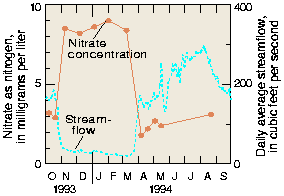Nitrate concentrations vary considerably in wells, requiring many samples to determine trends. However, in the Quincy-Pasco subunit many irrigation wasteways and other surface drains receive large contributions from ground-water discharge. For example, about 60 percent of total nitrogen discharged annually by EL68D Wasteway (site D, fig. 14) comes from ground-water discharges to the wasteway. From November to February, irrigation water is not delivered and storms large enough to produce runoff are rare. During this time, streamflow is low and ground water is the predominant source of nitrate in surface water conveyed by wasteways (fig. 16). Therefore, in the Quincy-Pasco subunit, samples of surface water during winter can be used to monitor nitrate trends in ground water for a large area. Base-flow surface-water sampling can also be used to track occurrence and trends in other dissolved constituents in ground water, including pesticides such as atrazine (p. 13).

Figure 16. Nitrate concentrations at EL68D Wasteway (site D, fig. 14) are highest during the winter when the main source is ground-water discharge and there is little dilution by canals or return flows [2].
Base-flow sampling in Palouse subunit streams is less indicative of ground water for several reasons. Base flow in the Palouse subunit occurs during the summer when plant growth is high; uptake of nitrogen by aquatic plants can greatly decrease nitrate concentrations in surface water. In addition, a substantial percentage of Palouse River flow in the summer is high-nitrate discharge from wastewater-treatment plants.
In most parts of the Quincy-Pasco subunit, base-flow concentrations of nitrate in wasteways and other surface drains have increased since the 1960s -- indicating an increase in nitrate concentrations in ground water. Best management practices (BMPs) in use in parts of the subunit may in time decrease these concentrations. However, changes in ground-water quality may not be apparent for decades or longer.
In Frenchman Hills Wasteway, base-flow nitrate concentrations doubled from about 3 to about 6 mg/L between 1966 and 1990 and appear still to be increasing (fig. 17). Ground water is the source of nearly 100 percent of base flow in the wasteway, so nitrate concentrations in nearby ground water have likely followed the same trend.
Base-flow nitrate concentrations are still increasing in Crab Creek at Beverly, but the increase has slowed since 1980. This trend is similar to trends that occurred in fertilizer sales (fig. 7) and irrigation (fig. 8) in much of the drainage basin. In addition, concentrations may be leveling off at this site because of contributions from the Crab Creek Lateral subbasin, where concentrations are decreasing.
In Crab Creek Lateral, base-flow concentrations of nitrate decreased from about 8 mg/L in 1966 to about 6 mg/L in 1991. This decrease may be partially explained by changing farming practices. For example, although the total amount of irrigated cropland draining to Crab Creek Lateral has not decreased, from 1974 to 1990 the proportion of this land used for orchards increased from 9 to 29 percent. Orchards require less applied nitrogen than do many of the row crops that they replaced [16].
Figure 17. Three sites in the Quincy-Pasco subunit show varying trends in nitrate concentrations at base flow (Nov.-Feb.) from 1960-91. In Frenchman Hills Wasteway (site E, fig. 14), concentrations doubled. At Crab Creek at Beverly (site F), the increase has slowed since 1980. In Crab Creek Lateral (site G), there has been a decrease.